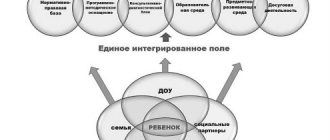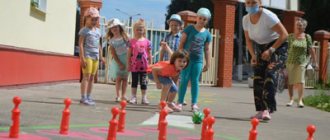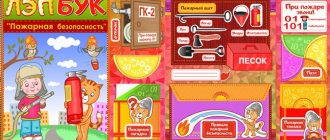What is a lapbook
This is a didactic aid used by teachers and parents to make it easier for the child to perceive the material, which is presented in an attractive playful way.
Its use is effective in developmental classes for children of senior preschool and sometimes primary school age. The subject of lapbooks can be different, but most often they are used to master knowledge that is not related to the main curriculum. The bright folder attracts the child’s attention, and the tasks and interactive component involve the child in the learning process through direct participation, rather than listening to boring stories from the teacher. The “Professions” laptop book can contain information about several popular types of activities, their features, equipment used in work, uniforms or tools. It is best to use the manual in a group as part of a separate project or thematic week. This, in addition to gaining knowledge, will give the child the ability to work in a team.
Stages of making a “knee book” (step by step)
If a lapbook is the final stage of a project activity, then it is made simply: take a capacious folder, collect all the materials accumulated during the project (drawings, task cards, children’s flat products) and place them in appropriately sized pockets. Next, children can use the folder to remember their participation in the project and discuss their impressions of it.
But making a laptop can also become a separate project, in which case careful and painstaking preparation is required. It consists of the following points:
- You need to decide on a topic. At younger and middle ages, traditional topics are taken, such as “Seasons”, “Wild and Domestic Animals”, “Vegetables and Fruits”, “Transport”, “Professions”. Older preschoolers will be interested in “Animals of hot countries”, “Space exploration”, “Amazing things in the natural world”, “Protecting our planet”. Together with your parents, you can make folders “Horoscope of our group”, “We work”, “Holidays of our group”, “What is school”, “Professions of our mothers and fathers”, “Ecological kaleidoscope”, etc.
- Drawing up a plan, according to the points of which information on the topic will be searched.
- Making a layout, this also includes choosing the design of individual parts of the laptop. Children and adults discuss what information is best presented in the form of a book, rotating circles, drop-down pockets, windows, and other things. The layout is sketched, and in the future the production of the folder will be based on it.
- Studying the topic, searching for information. Adults should teach the child how to collect information from different sources (books, magazines, excursions, observations). You can organize a trip to a museum or library. If a child owns a computer, he can search for some information on the Internet together with his parents. Do not allow the Internet to become the only source of information - this will significantly narrow your child’s horizons and negatively affect his communication abilities.
Even parents of students can be captivated by making a laptop
Benefits of use
Unlike other common teaching materials (maps, illustrations, games, competitions), the Profession lapbook allows the child to feel independent choice. The kid is directly involved in everything that happens, he himself determines the profession he likes, finds cards with images of workers, correlates them with the necessary attributes, and describes the main functions of the employee. This approach helps in socializing children, developing their imaginative and logical thinking, and developing the ability to take responsibility for their decisions.
Lapbooks are usually developed by teachers, but the participation of parents in the process of selecting and registering professions will also be useful. This will allow us to include more interesting and relevant activities in the list today. Teachers often make the mistake of using the same material for years, not paying attention to changes in the labor market. Older preschoolers can also actively participate in creating an album about professions (look for suitable pictures in magazines, cut and paste them, sort them in different directions).
The main tasks performed by a laptop:
- educational: to show the importance of work and the need for different professions, to form a conscious attitude towards them;
- developmental: help improve attention, coherent speech, memory, thinking, imagination. In addition, the development of fine motor skills and the ability to communicate with peers and elders are of great importance;
- educational: increasing respect for work, including one’s parents, developing skills of independence and cooperation.
The baby learns to independently collect and classify the necessary information. Increasing the child’s knowledge about various types of useful work, their significance for society, features, disadvantages and advantages is a good basis for broadening their horizons and increasing interest in the world around them.
Now the “Profession” lapbook can be bought in a store or ordered online (several files in PDF format for 15–20 A4 sheets cost 200–300 rubles). However, in order to unite a team of adults and children with a common goal, it is better to create it yourself. Some make it from scrap materials, others find everything they need on the Internet, create a layout on the computer, and then print it out on a color printer and paste it onto cardboard blanks.
Making an interactive folder
Professions related to industry
The work is creative. Let me show you an example of a laptop for preschoolers.
First, we need to decide on the topic that we will cover using the interactive folder. Our theme is “Professions”.
The task is to consolidate the child’s understanding of well-known professions, such as doctor, teacher, salesman, cook, builder, driver, etc.
Expand your knowledge of lesser-known professions. Enrich your vocabulary. And at the same time, arrange training for fine motor skills, memory, attentiveness, thinking, and speech.
We’ve decided on the topic, now we’ll figure out how to present it all and draw a layout on a simple piece of paper with a checkered pattern.
This is what it will look like when closed.
This is its cover, front side. We will place the name and several thematic pictures on it.
And this is what will be inside the folder.
Now, based on the existing layout, we begin the production of our educational and gaming aid.
Let's take thick A3 cardboard as a base. You can find such cardboard in office supply stores. It's called binding.
If you don’t have such cardboard at hand, you can use something else. For example, a cardboard folder “Case” or any other cardboard folder.
Shoe boxes make great lapbooks. Where there is cardboard, there is cardboard! They are especially good for preschool children, as they have increased strength, inflexibility and indestructibility.
You can also use whatman paper as a basis, but then you should be prepared for the fact that the lapbook will not hold its shape well.
The A3 format is the most convenient, since a sheet of cardboard just needs to be folded, there is no need to cut and glue. We connect its opposite sides in the middle of the sheet and smooth out the folds. The base is ready.
If we are dealing with A4 size cardboard, then we will act according to the scheme shown in the picture below.
That is, in the middle we have an A4 sheet, and on the sides there are halves of an A4 sheet. You can connect the middle and side parts using glue and a paper strip.
So, the base is ready. Let's work on the front side of the folder. On the outer sides of the sashes we glue pictures created on a computer and printed on a color printer. Everything was as we planned. The word “Professions” and pictures depicting people of various professions.
If it is not possible to create pictures in a graphics editor and print them, then you can arm yourself with simple pencils, felt-tip pens and draw. It will also turn out beautiful.
Next up is the insides of our training folder. Looking at the layout, we prepare all the necessary laptop parts: envelopes, pockets, twisters, cards, books, openers, notepads, etc.
Again, we did everything on the computer and printed it out, but, again, you can draw, draw and cut everything with your hands.
All that remains is to glue everything to the folder and arrange the cards in their places.
All! Lapbook is ready! You can play, practice, learn and develop.
I think that now the question of what a lapbook is and how to make it is off the agenda. You can try creating your own interactive folder.
Here you can get inspired by another of our work. We made a lapbook for the school project “Shape, size, color. Patterns and ornaments."
That's all for today!
Enjoy your creativity and see you again.
Your SchoolLa.
What materials should a laptop contain?
The internal content of the manual can vary at the request of its creators; the imagination here is limitless. Typically, the selection of material depends on the age of the children; it is customary to focus on groups from 4 to 6 years old and from 7 to 10 years old.
In a lapbook about professions for middle school children, you can include the following developmental elements:
- cards with images of representatives of professions in a separate pocket (usually about 20 pieces);
- pictures with attributes of different types of activities in accordance with the number of professions;
- folding bed with classification of works;
- an empty piece of paper folded into a book so that the child himself can describe the option he has chosen;
- an envelope with a paper man and options for uniforms (workwear) that can be put on him;
- game “Guess the Profession” in the form of a rotating circle with illustrations of the place of work (office, factory, farm, bank, etc.);
- a book containing poems, proverbs and sayings about professions;
- mini-book with thematic riddles;
- black and white pictures that the child is asked to paint;
- pocket with tasks “Who does what.”
The same manual can serve as the basis for a lapbook for older children, but some elements need to be replaced with more complex ones. For example, you can add the following tasks:
- cards “History of Human Labor” indicating interesting facts tied to the time of appearance and stages of development of a particular work;
- a booklet with types of professions by type of interaction: “man – technology”, “man – nature”, etc.;
- an intellectual map for selecting an activity (the child answers the questions posed and ultimately chooses an option that is close to his interests);
- pyramid of professions (managerial, creative, performing).
Various manual authors offer a wide selection of different games (lotto, puzzles, associations), puzzles, crosswords, competitions and quizzes. For example, you can invite your child to play as a hairdresser, substituting various hairstyles for a cut-out person’s face, or as a doctor, using pictures with attributes (thermometer, pills, stethoscope, syringe).
Who develops the manual
The author of a lapbook is usually a teacher. But if for younger preschool age the teacher is involved in both the selection of material and its design, then in the middle group parents can get involved in the design and search for information.
For example, in my practice, as part of the discussion of the topic “Professions,” I give students and their parents a project task to write a story about the professions that we cannot do without. Or compile a manual with pictures, riddles, games dedicated to one profession.
In older preschool age, children take an active part in the selection of materials for designing a lapbook: they find illustrations, cut them out, and glue them. As in the middle group, mothers and fathers are actively involved in the search for materials, for example, they compose crosswords, puzzles on the topic, or collect a “data bank” about the professions of the future (city farmer engaged in landscaping megalopolises, developer of home robots, etc.).
Parents and children can offer materials for a group lapbook, and the teacher selects the most suitable and necessary information on the topic
Tips for Creators
Experienced teachers and parents who help them without fail advise how to best make the manual:
- Since the “Professions” lapbook is created for active use by children, it is advisable to make it as durable as possible. For the cover, a plastic folder or hard cardboard is best.
- It is advisable to make the cards themselves, mini-books, and folding books from thick paper, since a standard sheet will last exactly one lesson. The best option is to laminate all the elements, but in principle, covering them with tape will also work.
- It is advisable to make pockets for placing information voluminous and glue them well to the base; both standard glue and double-sided adhesive tape are suitable for this.
- Children should be given the opportunity to actively participate in the event as equal partners. It is a good idea to leave a place where the child can write or draw their parents' professions to show their importance and usefulness.
- A good result comes from combining working with a laptop and watching thematic cartoons. This allows children to switch their attention and look at the material being presented from a different angle.
- The benefit itself should be attractive to the child. Don't be afraid to use bright colors (red, green, orange, yellow, pink). Adults often like muted tones, but in this case you need to adapt to the child’s psychology.
Well, about the most important thing: what professions to include in the lapbook. It is very important that the selected options interest boys and girls. In addition, the employment sector is actively developing, so you can’t get hung up on the standard hairdresser, postman or astronaut. We need to be creative and give children information about activities that are relevant today. You can talk about farmers and roboticists, IT specialists and stylists, accountants and athletes. Within the framework of a thematic week, it is rational to allocate separate days to describe different areas of human activity.
With the right approach to the matter, a laptop about professions will help develop a child’s interest in useful activities and respect for other people’s work. Children, doing research work, learn to think and interact with others, expand their vocabulary and expand their knowledge of the world.
Author: Alexey Kuznetsov
Lapbook as an original innovative guide, beautiful and useful
The author of the manual is considered to be American Tammy Dubey. She came up with the idea of filling a small folder with a variety of pictures, pockets, rhymes, and paper crafts to reinforce and preserve the information she had learned with her children. Photos of the first lapbooks found their way onto the Internet and this manual became the property of all concerned parents, educators and teachers. Lapbooking (production of lapbooks) is recognized as an innovative technology with many advantages.
The very name of the manual is translated from English either as a “knee book” or as a “folding book”, and both options are completely fair. Lapbooks are small in size (usually A4 format when folded) and it is convenient for a child to look at them while holding them on his lap. In addition, these wonderful books are full of riddles and secrets, they fold out and have many pockets, inserts, notepads, which in turn open, which is very much to the taste of little researchers and lovers of secrets.
Studying a laptop begins with looking at all the treasures hidden in it.
What game elements are included in the layout and why?
Lapbooks for preschoolers are distinguished by a greater (compared to school) presence of game elements. These are rotating circles, opening windows, moving parts and figures. The first impression of a lapbook is usually for both children and adults: it’s fun, entertaining. But this is how it should be, because preschool children learn about the world through play. The first two or three lessons with a laptop will definitely be devoted to studying its wonderful properties and capabilities as a toy, and only after that the kids will be able to comprehend the useful information contained in it
There is no need to rush children, their involuntary memory and attention are very developed, and without them noticing, by manipulating with pockets, circles and pictures, they will learn a fairly extensive amount of information
It is thanks to such unusual elements that kids really like lapbooks.
Benefits for preschoolers and teachers
Two significant features of the laptop should be noted:
Usually the title page of a folder already announces its topic.
The purposes for using lapbooks are also very diverse. This includes consolidating everything that children have learned during the project, learning to collect and systematize information, developing creativity and creativity, and fostering a caring attitude towards a product made collectively, and respect for common work. One of the most important objectives of the manual is considered to be the stimulation of cognitive activity in children, the desire to learn and remember new things, and in older preschool age, the awakening of the desire to learn.
Task cards
Pros and cons of the appraiser profession, where to study, how to become an experienced specialist + nuances and features of the profession
There are also a number of interesting templates for cards that will decorate the lapbook and help the teacher or parents make it more attractive for kids.
Photo gallery: examples of card design
When making lapbook elements, one should not forget about the characteristics of each age group of preschoolers. The folder for the little ones contains large elements, but their number is smaller; older children can cope with smaller notebooks, envelopes, and windows. In addition, educators and parents should remember that thematic folders will be in great demand by children. You should take care of the strength of each element: cover it with transparent film or tape.
Lapbooks, interactive thematic folders or lap books - no matter what these aids are called, they have great potential for the development of children and the activation of thought processes, cognitive interest, creativity and independence. Adults should not take all the initiative in selecting information and making a laptop, but helping kids, involving them in creating a folder using beautiful and simple templates will be very useful and exciting.
How to use a lapbook in kindergarten and at home
The manual is universal: it can be used in classes both in kindergarten and at home. Lapbook is convenient:
- to present new material on the topic;
- to practice acquired knowledge;
- for consolidation and repetition of material.
Based on the directions of use of the manual, we can conclude that an entire lesson can be built on its basis: update knowledge on the topic with poems, use knowledge in practice by solving riddles, playing, and consolidate the material covered by solving puzzles, solving crosswords and coloring.
Children can work with a lapbook both independently and in a group.
History of origin
Lapbooks really come from America. His “mother” is considered to be an American writer from Virginia, Tammy Dubey.
It is believed that it was she who came up with the wonderful idea of filling a cardboard folder with various pockets, pictures, cards, envelopes and using this folder to teach her children.
Then her creations found their way onto the World Wide Web, were liked by many and became widely known and wildly popular, not only in America, but also here in Russia.
Tammy also came up with the name for the interactive learning folders. She called them LAPBOOK.
"Lap" in English means "knees". And “book” means “book”. It turns out something like a “knee book”, and if you say it in competent Russian, then “a book on your knees”. What does this have to do with knees? The fact is that the lapbook should be very small in size, no larger than A4 format, and easily fit on a child’s lap so that it is convenient to play and study with it.








